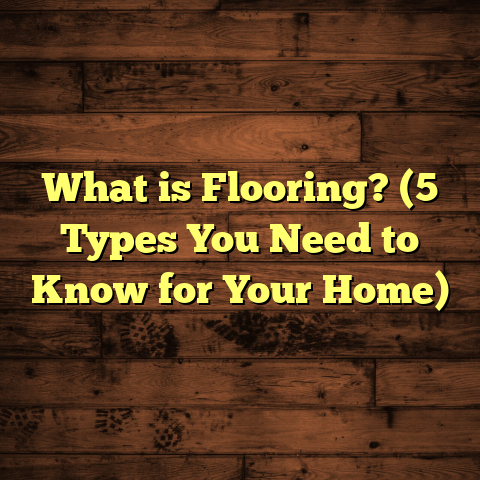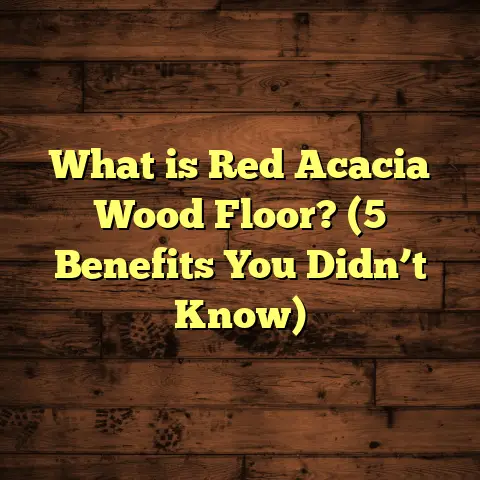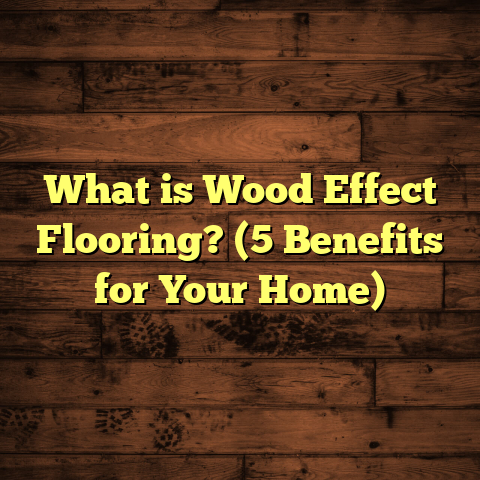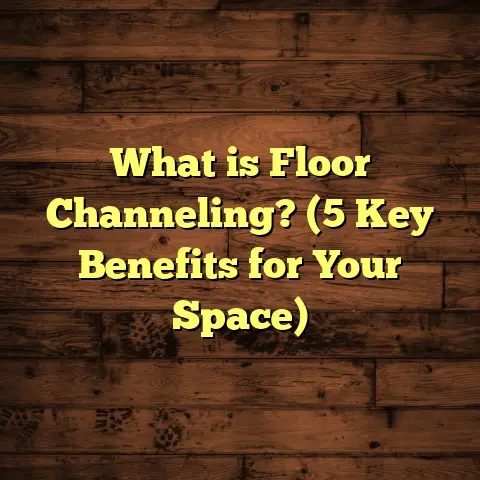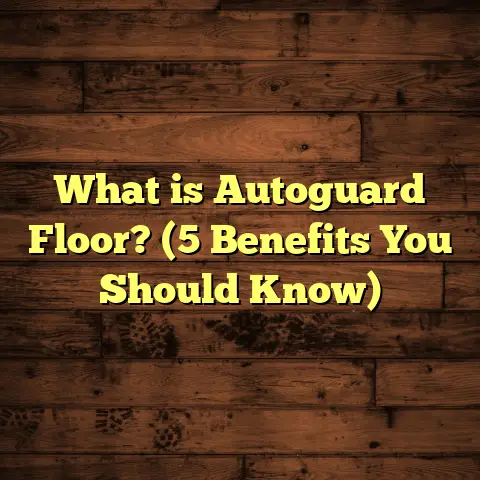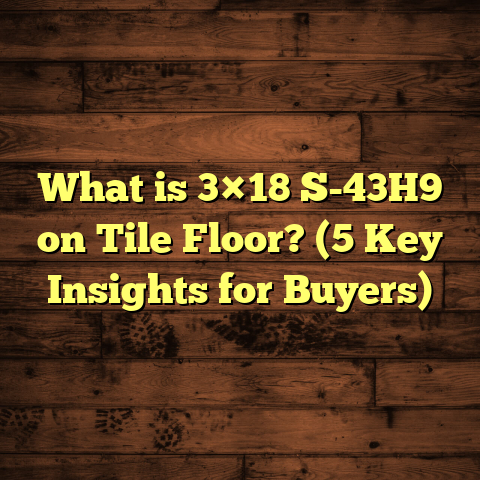What is Ghost Wood Flooring? (5 Facts to Elevate Your Home)
I remember the day I first saw ghost wood flooring up close.
It was in a cozy showroom bathed in natural light, and the floor
beneath my feet was unlike anything I’d walked on before. Subtle,
soft, and almost mystical in appearance — it made the whole space
feel calm and inviting. If you’ve ever wanted floors that feel like
they belong to a home with stories to tell, ghost wood might be your answer.
What Is Ghost Wood Flooring?
You might be wondering, what exactly is ghost wood flooring?
At its core, ghost wood flooring is a type of hardwood floor that carries
a pale, washed-out appearance while still showcasing the wood’s grain and texture.
Unlike traditional hardwood that highlights rich browns or reds, ghost wood flooring
has a delicate translucence — almost like you’re seeing the “ghost” of the wood’s natural beauty.
The Technical Breakdown
Ghost wood floors typically start with hardwood species known for their fine grain and durability—like white oak, ash, or maple. These woods inherently have tight grain patterns that lend themselves well to the ghostly aesthetic.
The manufacturing process involves several key steps:
- Selection of Wood: The process begins with choosing hardwood planks with consistent grain patterns and minimal defects. This ensures the final product will have a uniform yet natural look.
- Bleaching: The planks undergo a bleaching process using mild chemical agents. This step lightens the natural color by removing pigments but preserves the wood’s texture and grain.
- Sanding: After bleaching, the wood is carefully sanded with low-grit sandpaper to smooth the surface without removing the delicate grain details.
- Whitewashing / Staining: A diluted white or gray stain is applied to give the floor its signature washed-out look. This step is crucial because it adds depth without overpowering the wood’s natural features.
- Sealing: Finally, a protective matte or satin finish is applied to seal in the color and protect the floor from wear while maintaining its soft visual appeal.
The result is a floor that looks almost translucent but still feels warm and organic underfoot.
Why “Ghost”?
The term “ghost” comes from the ethereal, faded appearance of the wood grain beneath the translucent finish. It’s as if you’re seeing a whisper of the wood’s character rather than its full boldness.
This style creates a tranquil atmosphere in rooms — like the floor is quietly present but not demanding attention. It’s a subtle statement that many homeowners and designers find irresistible.
My Journey With Ghost Wood Flooring: A Personal Tale
When I first heard about ghost wood flooring, I was skeptical.
I’d installed hundreds of hardwood floors before and was used to the usual rich, warm tones that hardwood brings.
But I was working on a client’s home in a historic district where they wanted something different — something fresh but respectful of tradition. They’d fallen in love with this washed-out wood look from photos online but weren’t sure how it would hold up in real life.
I agreed to try it out in their living room, pairing white oak ghost wood planks with soft gray walls and minimalist furniture. The final look was beyond what I expected. The floor seemed to glow softly in natural light and gave the room an airy feel without losing warmth or texture.
That experience got me hooked. Since then, I’ve recommended ghost wood flooring for all sorts of projects — from beach houses to urban lofts — because it strikes a perfect balance between modern style and natural beauty.
What really surprised me was how many people thought the floor was some kind of high-end designer material costing a fortune — when in reality, it’s about smart finishing and craftsmanship.
5 Facts That Will Change How You Think About Ghost Wood Flooring
Let me share five facts about ghost wood flooring that have shaped my view and can help you decide if it’s right for your home.
1. Durability Is Real — Not Just Pretty Looks
One common misconception is that ghost wood flooring sacrifices strength for style. That’s not true at all. Because ghost wood uses hardwood species like white oak or ash, it remains tough and long-lasting.
To put it in perspective:
- White oak rates about 1360 on the Janka hardness scale (which measures resistance to denting). That means it’s harder than many common hardwoods like red oak (1290) or black cherry (950).
- The finishing process adds an extra protective layer without dulling the soft look. This means your floors stay resistant to everyday wear — whether from kids’ toys, pets’ claws, or heavy foot traffic.
In fact, I’ve seen ghost wood floors last decades when properly cared for. So if durability worries you, this flooring can stand up to life’s challenges just as well as traditional hardwood.
2. Grain Patterns Are Visible But Subtle — A Unique Texture
Ghost wood flooring showcases one of its most striking features here:
the grain pattern is present but softened. You still see beautiful linear grains, knots, and textures—but they’re muted under the whitewash or bleach finish.
This gives each plank distinct character without overwhelming your room visually.
In one project I worked on, a customer loved how this subtlety played with their coastal-inspired decor. The grain reminded them of driftwood found on beaches — natural yet understated.
3. Installation Requires Special Care — It’s Not “Just Another Floor”
Installing ghost wood flooring isn’t quite like installing standard hardwood floors. Because the finish is delicate and light-colored, sanding must be gentle to avoid removing too much pigment or damaging the grain pattern.
I’ve worked alongside installers who specialize in this finish. They recommend:
- Using low-grit sandpaper (around 120 grit) for any site sanding.
- Minimizing sanding passes.
- Applying finishes carefully with brushes or rollers rather than spray to avoid oversaturation.
- Allowing adequate drying time between coats to maintain translucency.
These extra steps add labor time but make all the difference in preserving the signature ghostly look.
4. Maintenance Is Simple but Requires Attention
Taking care of ghost wood floors is similar to caring for other hardwoods but with some additional considerations:
- Avoid harsh chemical cleaners that could darken or stain the pale finish.
- Use pH-neutral cleaners designed for hardwood floors.
- Sweep or vacuum regularly to remove dirt and grit that could scratch the surface.
- Clean spills immediately to prevent water damage or discoloration.
- Occasionally apply a protective polish suited for matte finishes.
I personally recommend microfiber mops and gentle cleaning solutions for everyday upkeep. This keeps your floors looking fresh without altering their color or texture over time.
5. Cost Can Vary Widely — Planning Tools Are Your Friend
Ghost wood flooring often costs more than typical hardwood due to its specialized finishing process and labor intensity. As a rough guide:
- Material prices range from $8 to $15 per square foot depending on species and finish quality.
- Installation labor can add another $4 to $8 per square foot because of extra care required.
- Additional costs include underlayment, baseboards, and sometimes custom finishing fees.
When managing multiple projects or trying to budget precisely, I use a tool called FloorTally. It lets me input details specific to ghost wood like species choice, plank dimensions, finish type, and local labor rates. It then calculates an accurate cost estimate including waste factors so I’m never caught off guard by unexpected expenses.
This helps me compare options quickly without juggling dozens of spreadsheets or supplier quotes — saving time and keeping my projects profitable without cutting corners.
How Ghost Wood Flooring Compares With Other Popular Flooring Types
I often get asked how ghost wood stacks up against laminate, engineered hardwood, or traditional hardwood floors.
Here’s what I’ve learned:
| Flooring Type | Appearance | Durability | Cost Range (Material + Installation) | Maintenance | Unique Pros & Cons |
|---|---|---|---|---|---|
| Ghost Wood Hardwood | Pale washed grain; soft & subtle | High (Janka ~1300+) | $12 – $23 / sq ft | Moderate; gentle cleaning | Unique look; natural wood; higher cost |
| Laminate | Printed surface mimics wood | Moderate; prone to scratches | $3 – $7 / sq ft | Easy; water sensitive | Affordable; less authentic feel |
| Engineered Hardwood | Real wood top layer | High; stable in humidity | $8 – $15 / sq ft | Moderate | Good moisture resistance; limited refinishing |
| Traditional Hardwood | Rich tones & visible grain | High | $7 – $18 / sq ft | Moderate; refinishing possible | Classic look; wide species options |
Ghost wood’s charm lies in offering genuine hardwood with a fresh twist on color and tone. It brightens rooms without feeling cold or artificial like some laminate options do.
A Closer Look at Manufacturing: From Log to Ghostly Floor
I find it fascinating how much work goes into creating ghost wood flooring behind the scenes. Here’s an inside view:
Step 1: Harvesting & Milling
The process begins at sawmills where logs are cut into boards. Only premium logs are selected for ghost wood because any defects or inconsistencies show through after bleaching.
Boards are kiln-dried carefully to reduce moisture content (typically around 6-8%) which prevents warping later.
Step 2: Bleaching & Color Treatment
Once dried, boards go through bleaching tanks filled with agents like hydrogen peroxide or oxalic acid solutions. This lightens the natural pigments without harming fibers.
The bleaching intensity depends on desired final color — some ghost woods are nearly whitewashed while others keep faint beige or grayish hues.
Step 3: Finishing Touches
After bleaching:
- Boards are sanded lightly by hand or machine.
- A translucent stain or whitewash is applied by brushing or spraying.
- Multiple coats may be added with drying time between layers.
- Finally, matte polyurethane or oil finishes protect without glossiness that would spoil the soft effect.
Research & Data That Support Ghost Wood Flooring Choices
I found some intriguing data points while researching ghost wood flooring trends:
- Market Growth: A 2023 report from Flooring Industry Insights showed bleached/whitewashed hardwood floors grew by 25% year-over-year in popularity among new builds and renovations.
- Light Reflection: Studies by Interior Design Research Institute found lighter toned floors can increase perceived room brightness by up to 15%, improving mood and reducing need for artificial lighting during daytime hours.
- Durability Stats: Hardwood species commonly used for ghost floors have average lifespans exceeding 30 years under proper care — similar to traditional hardwoods but with less visible wear due to muted colors hiding scratches better.
- Environmental Impact: Many manufacturers now use eco-friendly bleaching agents and low-VOC finishes aligning with green building standards for healthier indoor air quality.
My Experience Using FloorTally for Project Budgeting
Budgeting can get complicated quickly when working with specialty floors like ghost wood.
I remember once estimating costs manually for a 1,500 square foot project using multiple suppliers and installers’ quotes — it took days and still felt incomplete.
Now I use FloorTally regularly because:
- It integrates current local prices for materials & labor automatically.
- You can customize inputs including plank size, species, finish types relevant to ghost wood.
- It factors in waste percentages upfront so you order enough material without excess.
- Generates detailed reports I can share with clients or contractors easily.
- Saves me hours per project while improving accuracy — which means fewer surprises and better client satisfaction.
Stories From Homes Where Ghost Wood Made a Difference
I want to share two projects where ghost wood flooring played starring roles:
Coastal Retreat in Maine
A family wanted their vacation home to feel breezy but grounded in nature. We chose ash ghost wood boards finished with a light gray wash mimicking driftwood found on nearby beaches.
The floor anchored their neutral palette beautifully—soft whites on walls, linen upholstery—and gave every room a relaxed but refined vibe.
One guest told me it felt like walking on clouds rather than hard floors — probably because of how peaceful and open the space felt with those pale boards below.
Urban Loft in Chicago
A young couple renovating an industrial loft wanted their floors light enough
to brighten their space but textured enough to hide street dust and wear from city life.
White oak ghost wood fit perfectly with their metal-framed furniture and exposed brick walls —
offering warmth without heaviness. Because we used FloorTally early on, budgeting stayed on track despite custom finishes required for such a unique look.
Frequently Asked Questions About Ghost Wood Flooring
Q: Can ghost wood flooring be refinished?
A: Yes! Because it’s real hardwood under that finish layer, it can be lightly sanded and refinished if needed. However, refinishing should be done carefully to preserve the pale tones—usually by professionals familiar with whitewashed finishes.
Q: How does ghost wood handle moisture?
A: Like all hardwoods, it’s best installed in dry areas away from excessive humidity. Engineered versions of ghost wood can offer better stability in basements or kitchens due to layered construction but proper acclimation and underlayment are still important.
Q: Is ghost wood flooring pet-friendly?
A: Definitely! Its hardness makes it resistant to scratching compared to softer woods. Plus, its muted grain hides minor scuffs better than traditional dark stains do.
Q: What room styles suit ghost wood best?
A: It complements many styles—Scandinavian minimalism, coastal cottages, modern rustic spaces, even eclectic vintage interiors—because of its neutral tones and understated texture.
Final Thoughts From Me
Choosing a floor is one of those big decisions that shape how your home feels every day. Ghost wood flooring offers something fresh yet timeless—a quiet personality that supports your design without shouting over it.
If you want your home flooded with natural light reflections while keeping warmth underfoot, this might be exactly what you need.
And if managing costs feels overwhelming? Tools like FloorTally can take away much of the guesswork so you can focus on planning your dream space rather than crunching numbers endlessly.
So what do you think? Could ghost wood flooring be the subtle magic your home deserves? Or maybe you’ve seen it somewhere that caught your eye?
Either way, feel free to ask—I’m here to share everything I know about making your floors both beautiful and built to last.
If you want me to expand any section further or add specific case studies, let me know!
